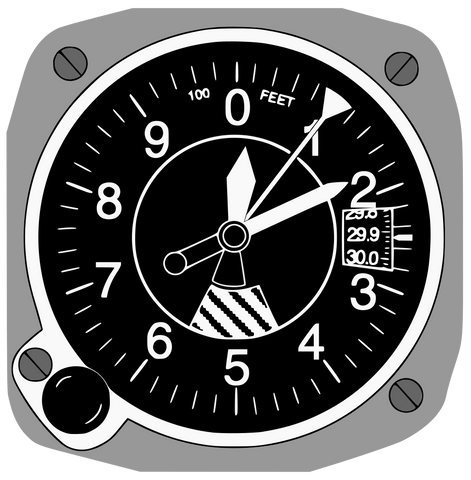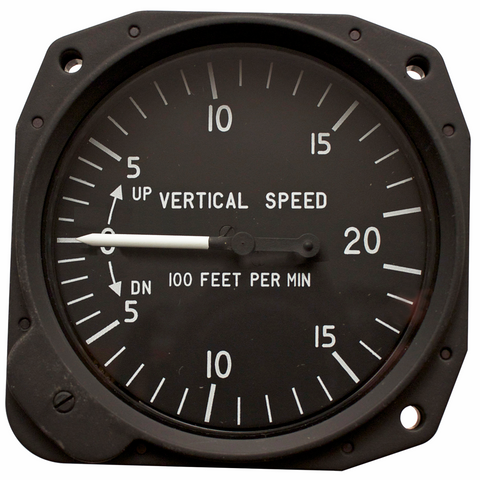What is the pitot-static system?
The pitot-static system is a pressure-based aircraft system that measures and compares ram air pressure and static pressure. That data is then transmitted to aircraft instruments in the cockpit, giving the pilot information on aircraft altitude, airspeed and vertical speed.
What components make up the pitot-static system?
The pitot-static system is made up of 4 types of interconnected components:
Pitot tube

The pitot tube is an L-shaped device typically mounted on the leading edge of the wing where it is exposed to the relative wind. The pitot tube has an electric heating system to prevent icing. This is controlled by a switch in the cockpit and is used during IFR flights.
The function of the pitot tube is to measure the dynamic air pressure, or ram air pressure – the air pressure created by the aircraft’s forward motion.
Static pressure port(s)
The static pressure port is a flush-mounted air inlet opening in the side of the fuselage. It is situated in an area with relatively undisturbed airflow.
For more accurate readings, some aircraft have two external static pressure ports – one mounted on each side of the fuselage.
Since the port is on the outside of the aircraft, there is a chance that it could become clogged with ice. Because of this, some newer aircraft also have an alternative static port located in the cabin. This alternative can be used if the primary port or ports are blocked.
The static pressure port’s function is to measure the ambient non-moving, or static, air pressure around the aircraft.
Pitot Lines & Static Lines
An important part of the pitot static systems are the pitot line is a pressure line that connects the pitot tube to the air speed indicator instrument. The static lines connect the static pressure ports to all three of the pitot-static instruments.
Pitot-static instruments
The pitot-static instruments translate the conditions that the pitot tube and static pressure port(s) are measuring. Three instruments are connected to this system:
- Altimeter: measures altitude
- Vertical speed indicator: measures the speed at which an aircraft is ascending or descending (in feet per minute)
- Air speed indicator: measures the aircraft’s speed through the air
How does the pitot-static system work?
To understand how the pitot tube and pitot-static system works, we will talk about the system one instrument at a time. We will clarify what the instrument displays and how the pitot-static system provides the measurements that are used for the instrument.
Altimeter

The altimeter, sometimes called the pressure altimeter or barometric altimeter, uses changes in static air pressure to determine altitude.
The airtight altimeter instrument case is connected to the static pressure port(s) via a static line. Inside the instrument is a sealed aneroid barometer which expands as pressure decreases and contracts as pressure increases.
A higher pressure translates to a higher altitude and a lower pressure translates to a lower altitude. The altimeter should be calibrated prior to takeoff so that it is reporting static pressure in terms of altitude above sea level.
Vertical Speed Indicator

The vertical speed indicator (VSI) – also known as the variometer or vertical velocity indicator (VVI) – is also connected to the static pressure port(s) via a static line.
The purpose of the vertical speed indicator is to translate changes in static pressure into vertical speed in feet per minute. To accomplish this, the VSI instrument is built of a sealed case with a metered leak at the back of the case.
The static pressure enters the instrument through a thin sealed diaphragm that is connected to the static pressure port. If the aircraft is changing altitudes, there will be a pressure differential between the air entering from the static line and the air slowly leaking through the back of the case.
The VSI gauge measures that pressure differential and translates it into feet per minute of ascent or descent. On ascent, the diaphragm will contract faster than the calibrated leak, so the indicator will display a positive vertical speed. As the aircraft descends, the diaphragm will contract slower and a negative vertical speed will be indicated.
Once the aircraft levels off and remains at the same altitude, the incoming and outgoing pressures within the instrument stabilize, and the indicator reads zero.
Air Speed Indicator

The air speed indicator is connected to both the static pressure port and the pitot tube. This indicator compares the difference between the static pressure and the pitot pressure to calculate dynamic pressure.
The dynamic pressure is then translated into air speed. A greater dynamic pressure means a higher airspeed and a lower dynamic pressure means a lower airspeed. To compare these readings, a pressure diaphragm is connected to the pitot tube, and the airtight case around the diaphragm vents to the static port.
As the aircraft goes faster, increased pressure is experienced by the diaphragm, providing the pitot pressure portion of the reading. Slower speeds result in decreased diaphragm pressure. It is important to check the pitot tube thoroughly and ensure it's not blocked or obstructed.
Common problems and errors with the pitot-static system
The pitot-static system is not without its inherent weaknesses, and there are some common problems and known errors that pilots should be aware of. For a visual overview complete with system diagrams, watch ifrPilot-david’s video on Pitot-Static System Errors.
Static vent blockage
As we mentioned, it is possible to develop a blocked static port (most often by ice), and this is one of the reasons that aircraft can have two or even three vents. If your static vent is blocked, it will affect all three of your pitot-static instrument displays. The static pressure in the gauge will remain as it was before the vent became blocked.

(source: FAA Pilot’s Handbook of Aeronautical Knowledge)
Effect on Altimeter
Your altimeter will continue to read the altitude you were at when the blockage occurred, regardless of your true altitude.
Effect on Vertical Speed Indicator
Your VSI will get stuck at zero and be unable to register changes in vertical speed.
Effect on Air Speed Indicator
When you change altitudes, the display on your airspeed indicator will also be incorrect. As you descend, the airspeed will start reading higher than it really is. If you ascend, your registered airspeed will decrease.
Solution
If your aircraft has an unpressurized cabin and an alternative static vent located within the cabin, you can switch to that vent.
If you do this, be aware that the altimeter may indicate a higher altitude and the airspeed indicator may show a greater than actual speed. The vertical speed indicator will likely show an initial ascent, then return to a correct reading.
(source: FAA Pilot’s Handbook of Aeronautical Knowledge)
Pitot tube blockage
Since it is open to the elements, the pitot tube can also become blocked by ice or even bugs. Since the pitot tube is connected to just the air speed indicator, this is the only instrument that will be affected.
If a blocked pitot tube occurs on the ground, you will notice that your air speed indicator continues to read zero even as you begin to accelerate for takeoff.
An in-flight blockage likely won’t be noticed as quickly, however since the air speed indicator measures the difference between static and pitot pressure, a stuck pitot pressure will skew your dynamic pressure reading.
When you ascend or descend, the static pressure will change while the pitot pressure will remain artificially constant. Therefore, regardless of true airspeed, indicated airspeed will decrease as you descend and increase as you ascend.
Solution
If you have a pitot heater and are flying IFR, use the heater to keep the pitot tube from icing up. Conduct a thorough pre-flight check of the pitot tube to catch a blockage on the ground.
Inherent system errors
Certain conditions are known to cause errors in the pitot-static system. For example, density errors may appear thanks to variations in atmospheric pressure and temperature.
The instruments are calibrated for standard sea level, so high airspeeds (above 200kn) and high altitudes (over 10,000 feet) are known to cause compressibility errors and indicate incorrectly high airspeeds.
Position errors thanks to flawed static pressure readings and lag errors due to the amount of time it takes an instrument to register a pressure change are also potential concerns.
The moral of the story for inherent system errors is to learn your aircraft and be aware of known errors before you are in the air so you aren’t taken by surprise.
A solid understanding of how the pitot tube and pitot-static system works and what can go wrong will help keep you out of trouble and flying safe.
Take Away
In the world of aviation, safety, and excitement go hand in hand, and the Pitot tube embodies this balance perfectly.
Pilots understand the exhilaration of flight and the importance of reliable data. The Pitot tube is a stalwart companion, translating air pressure into crucial speed information that underlies our every move.
Alongside it, air pressure's unchanging presence serves as a reliable guide as we navigate the skies. The collaboration between the Pitot tube and the static port forms the backbone of accurate readings, encapsulating the essence of flight in a blend of momentum and calculated pressure shifts.
So, while the skies offer us a sense of freedom and adventure, it's the teamwork of the Pitot tube, air pressure, and the static system that ensures our experiences remain both thrilling and secure throughout our aerial journeys.
Want to learn about Airspeed and the Airspeed Indicator?
Check out our articles related to Airspeed!
- How it Works: Airspeed Indicator (Extensive Guide)
- The 4 Types of Airspeed: How Each Works (Complete Guide)
Read more about Airspeed Indicators and other flight training topics in our Flight Training Material: Private Pilot collection.
Learn more about aircraft systems in the Jeppesen Private Pilot Manual.














2 comments
Relyn Kitson
In the caption just below the altimeter, it seems like the sentence “A higher pressure translates to a higher altitude and a lower pressure translates to a lower altitude.” Shouldn’t it be that a lower pressure translates to a higher altitude? The lower pressure allows the sealed aneroid barometer to expand, and thus read a higher altitude.
mike woitt
I was using your site as a reference to what I needed to know about the Avro Arrow.